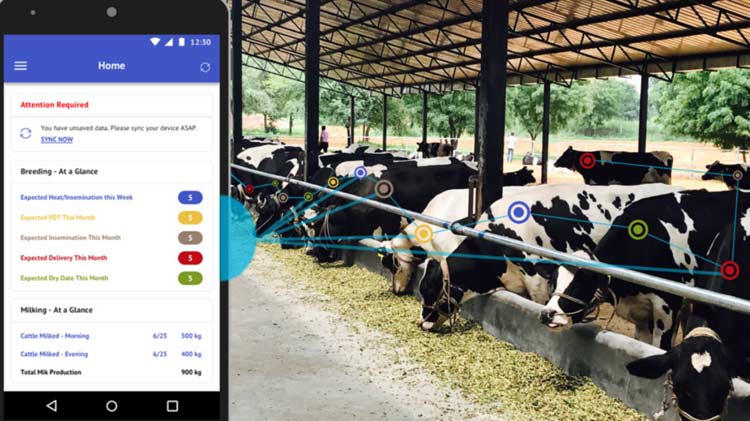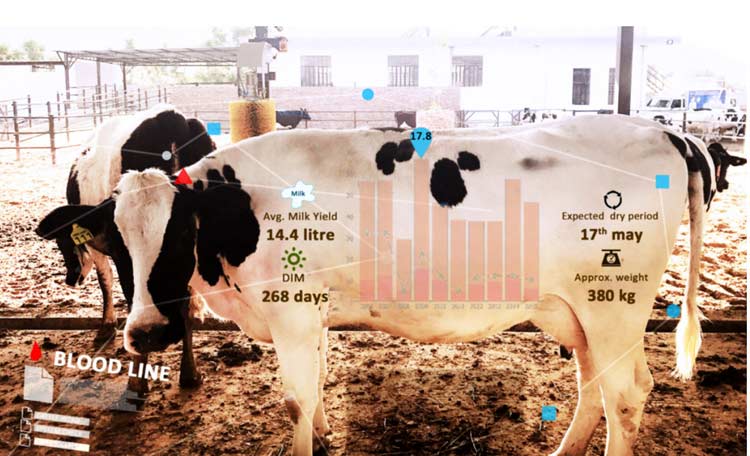
Agriculture is undergoing an evolution and technology is fast becoming an indispensable part of farming. To a great extent, the agricultural industry relies on innovative ideas and technological advancements to help increase crop yields. From automation and robotics to connected livestock, the next generation of farming is indeed going to leave us amazed. Today, the Internet of Things is a major driving force behind increased agricultural production at a lower cost. This has left the doors wide open for engineers to come up with smart IoT-based solutions that ensure to enhance agricultural productivity in a cost-effective manner. A research firm estimates that between 10 - 15 % of farmers use some sort of IoT in agriculture solutions spending a good amount for the adoption of new technologies. The use of smart solutions powered by IoT is expected to see a compound annual growth rate of 20% in the agriculture industry. We have already discussed how IoT is Transforming Food Industry in our previous article.
With IoT based sensors like the ones developed and manufactured by startups like NEERx, farmers can get accurate and real-time microclimate information. The farmers can monitor the field conditions from anywhere. IoT-based smart farming is highly efficient when compared with the conventional approach.
Now, the question that arises is as to what are the major changes that we can expect IoT to bring about in the agricultural industry in the future? Well, it is anticipated that the global population will reach around 9.6 billion by 2050 and the demand for more food is going to be challenging. IoT is fast paving way for smart farming and is ensuring to help farmers face the challenges to meet the demand for more food. The agriculture IoT market is expected to grow from to $ 20.9 billion by 2024 owing to the increasing population. The graph of the increase in adoption of Internet of Things (IoT) and Artificial Intelligence (AI) technology by farmers and focus on livestock monitoring for disease detection to improve farming efficiency is rising high.
How IoT is helping in Tracking and Monitoring Livestock?
Today’s technologically advanced-era where smartphones, tablets, and fitbits with added features are tracking our every move is making is become accustomed to the idea of data points monitoring behavior. Application of the Internet of Things in agriculture promises previously unavailable efficiency, reduction of resources and cost, automation, and data-driven processes enabling farmers to get high-quality crop yield. IoT technology has spurred positive changes in the way farmers keep tabs on grazing animals, such as sheep and cows. Nowadays, more and more lightweight, compact, and comfortable IoT devices are being developed to help farmers get data of the location, health, and well-being of cattle.
The smart IoT-based sensors are being placed into a cow's throat and stomach, worn around the animals’ neck as fabric-covered collars or as an ear tag that has tracking capabilities and communicates via Bluetooth. The IoT devices enable farmers to monitor animal’s health, location, eating habits, and reproductive cycle to the herd’s grazing and movement patterns in a pasture.

Advantages of IoT-Based Livestock Monitoring
Various livestock sensors can help farmers get notified on when animals have roamed away from the herd, their location, data related to the health of the livestock, and much more. It helps in identifying sick animals, lowering down labor costs, and face specific challenges while instrumenting the livestock with the sensors.
Tracking Location
Many times, farmers have to struggle hard to find the lost livestock that gets separated from the herd due to reasons like ill health or if they are in heat. The IoT wearable devices ensure to provide relief to the farmers as with this livestock can be easily traced that too without sparing much time. IoT devices help in tracking the movement pattern of animals, optimizing their grazing patterns, and others. Also, if there is any change IoT devices notice in the behavior of livestock, the farmers get notified for the same. Moreover, the movement tracking can help maximize a farmer’s pastureland. With the data that a farmer gets by tracking each animal’s movement and herd’s migration, the grazing patterns can be optimized.
Monitoring Health
Continuously monitoring the health levels of livestock is vital to ensure the diagnosis of the diseases, if any, at the early stage. Wearable IoT devices with built-in sensors when mounted on the animals help capture data and notify about the health of the livestock. These devices enable farmers to monitor heart rate, blood pressure, respiratory rate, temperature, digestion, and other health-related data. Also, monitoring the health of the livestock ensures the reduction in livestock feeding issues too. Without IoT monitoring, various health problems and feed issues in a herd may go undetected until one or more animals require veterinary care. By continuously measuring each animal’s condition and behavior, farmers can take action at the right time.
Fertility
The IoT-based devices make it easier to monitor and measure reproductive cycles of the cow and know when a cow goes into heat. Additionally, an IoT sensor can send an alert to the farmer when the cow goes into labor making the calving process safer and the farmer does not have to continually check the cow to see if she has started calving.
Lactation
The IoT devices rolled out to manage the livestock also help farmers in maximizing the livelihood of the livestock. With these devices, it is easy to correlate cattle movement with specific behaviors like pasturing, lying down to chew the cud, and more. The IoT devices can also help in tracking the right time for milking, measuring the milking amount and speed, etc. The data gathered from the cow’s activity allows a farmer to help cows improve their diet and increase lactation. This eliminates guesswork and increases the length and quality of milking sessions.
How IoT is revolutionizing livestock health-promoting data-driven decision-making is a vast topic. To understand more about the technology that is helping farmers improve the crop yield by livestock management, we asked the Ex-CEO of INHOF Technologies to shed some light on it.
Here is what he said: “When we talk about sensors in dairy, we are talking about heat belt or activity monitoring system. These technology monitors activity and rumen count to understand cattle health and ovulation cycle. Existing technologies are good systems to support paint points to track activities. That is why European countries developed and adapted this technology. The main issue they faced was when the size of the herd was bigger as the system didn’t enable them to track activities and automate it.
In countries like India, cattle health, semen quality, and service quality are more important parameters for cattle to conceive than detecting a peak heat period of cattle. Cattle health activity needs to be tracked and maintained 365 days a year. The most important parameter required to maintain health is to feed and fodder availability. Farmers need to understand the need for a quality feed and keep patience for cattle to accumulate with the feed whenever the feed is changed. The second parameter is the management. The lower stress cattle will have, the better the cattle will perform on a farm. Semen is an investment in future breeds. Farmers need a lot of logical and conditional ability to take this decision. Stakeholders of the industry should support to upgrade farmers in this. Solving these basic problems will ensure that there are no basic health issues in farms.”

We also sat down with Sarvesh Gupta, Senior Engineer at Factana Computing to know his viewpoint and understand the role of IoT in livestock management. To which he said:
“IoT-based sensors like heartbeat sensor, body temperature sensor, RFID, biosensors help in predicting illness in livestock, reduce the occurrence of illness by building a food quality monitoring system. To build a food quality management system, chemical and biological IoT based sensors can be used which can monitor different parameters of food. IoT-based Gyro, GPS, and proximity sensors can help detect movement, location, and object around livestock. Data like health information, location, movement, weather information, etc. is thus collected and analyzed for the right decision making.
In livestock management, data communication should be real-time without any delay, also reduce redundancy of data. Therefore, it is important to build analytics to filter the data and save only the required data to the cloud for further analysis. Despite the number of advantages of IoT-based sensors, selecting the communication medium between sensors and cloud is always a challenging part. The communication protocol has some limitations like if we choose 3G/4G/LTE, we should have a strong network in that area, otherwise, data may be lost. Moreover, choosing LoRaWAN/NB-IoT/Sigfox (trending technology in IoT for communication) be an expensive affair.
The alert mechanism in case of emergency is a must without any delay. There is no single sensor that can read all the required parameters. Integrating all sensors to a single module and making it wearable and compact is challenging too. The need of the hour is to integrate all required sensors to a single module and then use trending technologies in IoT which is LoRaWAN, NB-IoT, Sigfox to achieve long-range communication which is almost 5KM in an open area. Receiving real-time data and creating some analytics to visualize data is the key.
The Fogwing IIoT (Industrial IoT) Platform build to be used with LoRaWAN or Edge computing-based solution to provide real-time data and a basic level of analytics to visualize the data. Besides, it gives API access to build an application for the solution. Framework diagram here shows how the Fogwing IIoT platform can be implemented.”
After a lot of research work and discussions with companies manufacturing IoT-based sensors for livestock management, we can say that IoT and AI are two revolutionary technologies that are helping farmers in optimizing their crop yield and promoting livestock health through remote monitoring and data-driven decision-making. All that needs to be done is catering to the need of the hour and making low-cost effective modules with all the sensors integrated and using trending technologies for real-time data. With the agricultural industry turning digitalized at a fast pace, we can expect to see farmers increase their revenue and heave-a-sigh of relief to a large extent.






Really thanks for giving this IoT information really useful for me as electronics engineer!